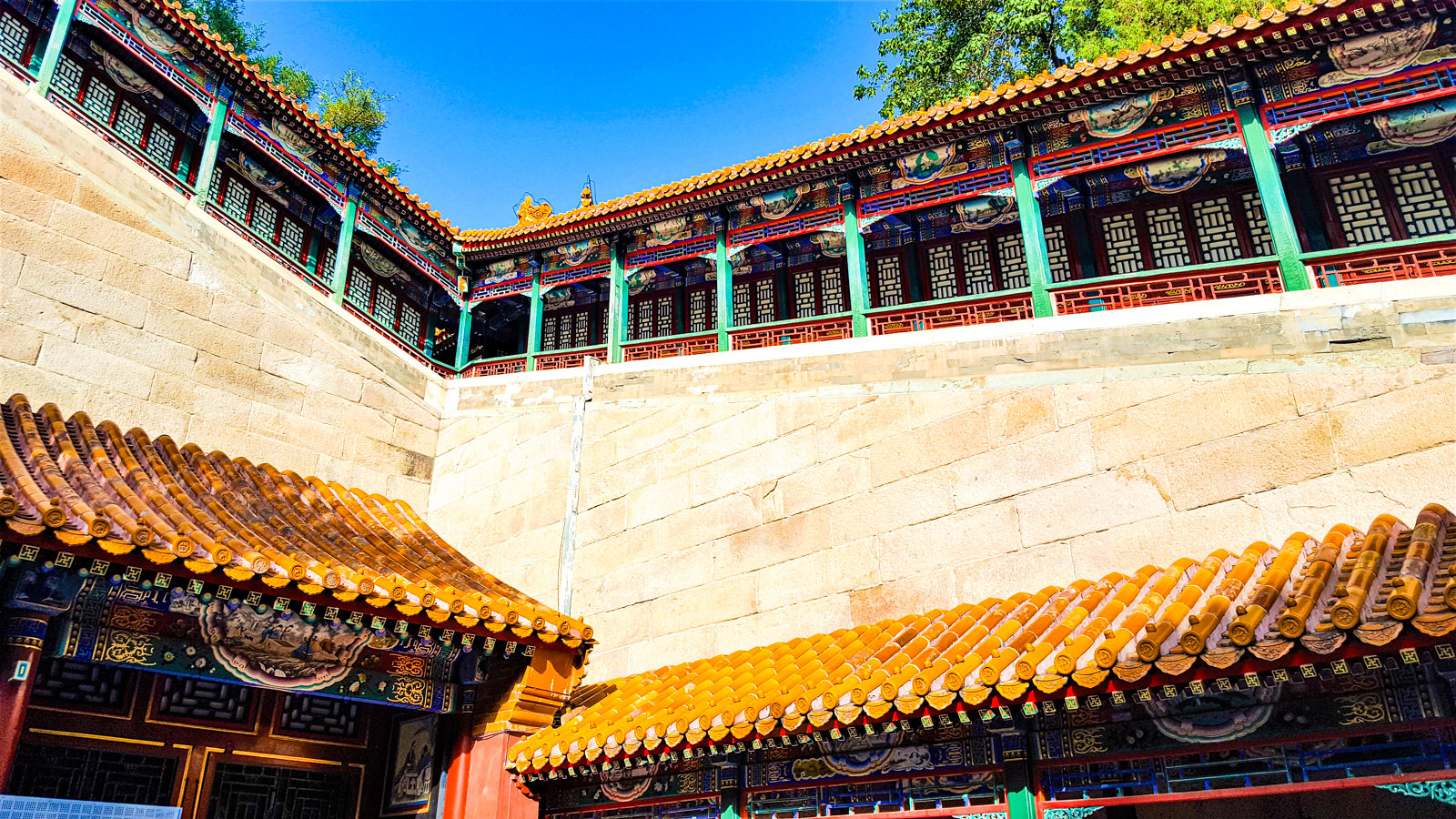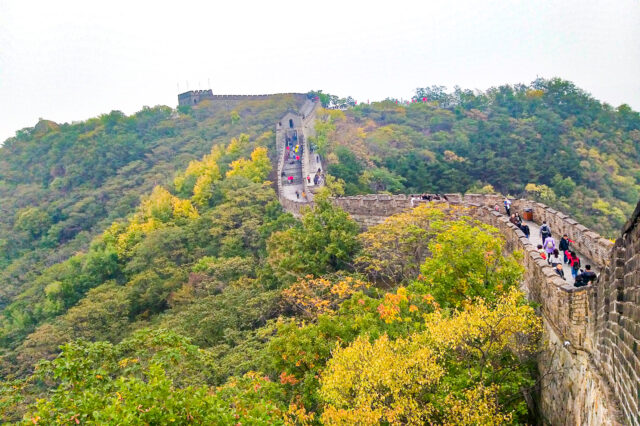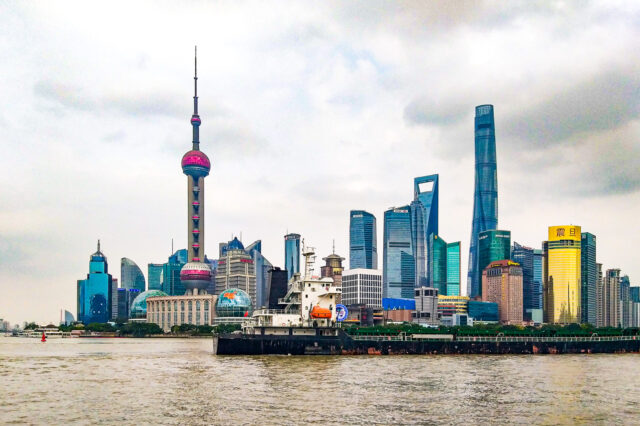Quick heads‑up, fellow travelers: Hit the Road Ket contains some affiliate links. Book through them and I earn a small commission at no extra cost to you – fueling my caffeine fix and future travels! For more details, see my Disclosures.
The Beijing Summer Palace was, unexpectedly, one of the highlights of our visit to China. Compared to other world-renowned sites in and around Beijing, this UNESCO World Heritage Site is less talked about, although thousands of tourists swarm it every day. I certainly had heard of it and seen some photos, but it exceeded all expectations. This could easily be one of my favourite places overall, if not for so many people.
The palace was built in the 18th century for the dowager empress Chongqing. It served, as summer residence of the emperor’s family. The Palace complex was destroyed in the mid 19th century and rebuilt in 1886 by Empress Dowager Cixi, who moved here. From the history I read about her, she sounds like a powerful woman, who loved art and culture. The Palace is particularly revered, due to its gardens and beautiful lake surroundings.
Practical Details for Visiting the Summer Palace
How to Get to the Summer Palace
If you are staying near any metro station in Beijing, getting here will be easy using Beijing’s extensive metro network.
- Xiyuan Station exit C2 is 10 mins away from the East gate of the Palace.
- Beigongmen station exit D is 3 minutes away from the North gate, walk to your left after getting out of the station.
You can enter from one gate and exit from another, that’s the best use of your time. We entered from the North side and walked all the way to the East gate to get to the Xiyuan station, nearby which there were a number of food and coffee places.
Note: Keep in mind, if you want to find any food, head towards the Xiyuan station, as there is a shopping area and a lot of food options here. More about this later.
Tickets of the Summer Palace
Through ticket: 60 yuan (high season price)
General admission ticket: 30 yuan (high season price)
Discounts for children and pensioners available for either option.
Important Note: Suzhou Street, Dehe Garden, and the Tower of Buddhist Incense are closed on Mondays, except on national holidays. Other areas remain open.
If you want to visit most places around the grounds, I suggest buying the Through ticket rather than buy the general ticket to access the grounds and then buy tickets one by one at the entrance of each site.
You have several options for buying the tickets:
- You can buy the ticket at the ticket office, however in high season, especially on weekends, the queues can be huge. There is also a chance that the tickets may sell out.
- As most tickets in China, you can buy Summer Palace tickets on WeChat. I am pretty used to using most major booking platforms, but WeChat is quite a unicorn for me. It kept getting stuck and logging me out. It was a nightmare. Hopefully it works for you though. If so, you can get tickets for the same price, as at the ticket office of the Palace.
- If you wish to buy tickets online in advance, the official website has a link for purchasing tickets, however it doesn’t work (at least it doesn’t at the time of writing. I am still including it for ease of reference).
- Easiest option for international travelers is buying buy a ticket on either Klook or Trip.com or GetYourGuide for a small surcharge.
If you choose buying tickets online, you can do so a week in advance of your visit.
When purchasing tickets online or in person, you need to have your passport with you during your visit.
While exploring the Summer Palace is easy on your own, there are options for getting a tour guide to explain to you the history of the Palace. You can either hire one on the spot or purchase the tour beforehand after reading the reviews.
Moreover, if you have a very limited time in Beijing, you may consider a whirlwind tour of the city, which includes the major attractions. However, I wouldn’t advice doing this, unless you have only a day and don’t anticipate visiting Beijing again.
How Much Time do you Need to Visit the Summer Palace
You should keep in mind that the Palace grounds cover a huge area around the lake. The Palace complex consists of over 3000 man-made structures, from pavilions to towers to bridges. For exploring all main areas of the grounds on a comfortable slow stroll, you would certainly need the whole day. We spent over 5 hours here and that wasn’t nearly enough. Therefore, depending how much time you have in Beijing, try to allocate at least half a day to the Summer Palace.
Map of the Summer Palace
I couldn’t find a great map for the palace grounds; this TravelChinaGuide map gives some idea.
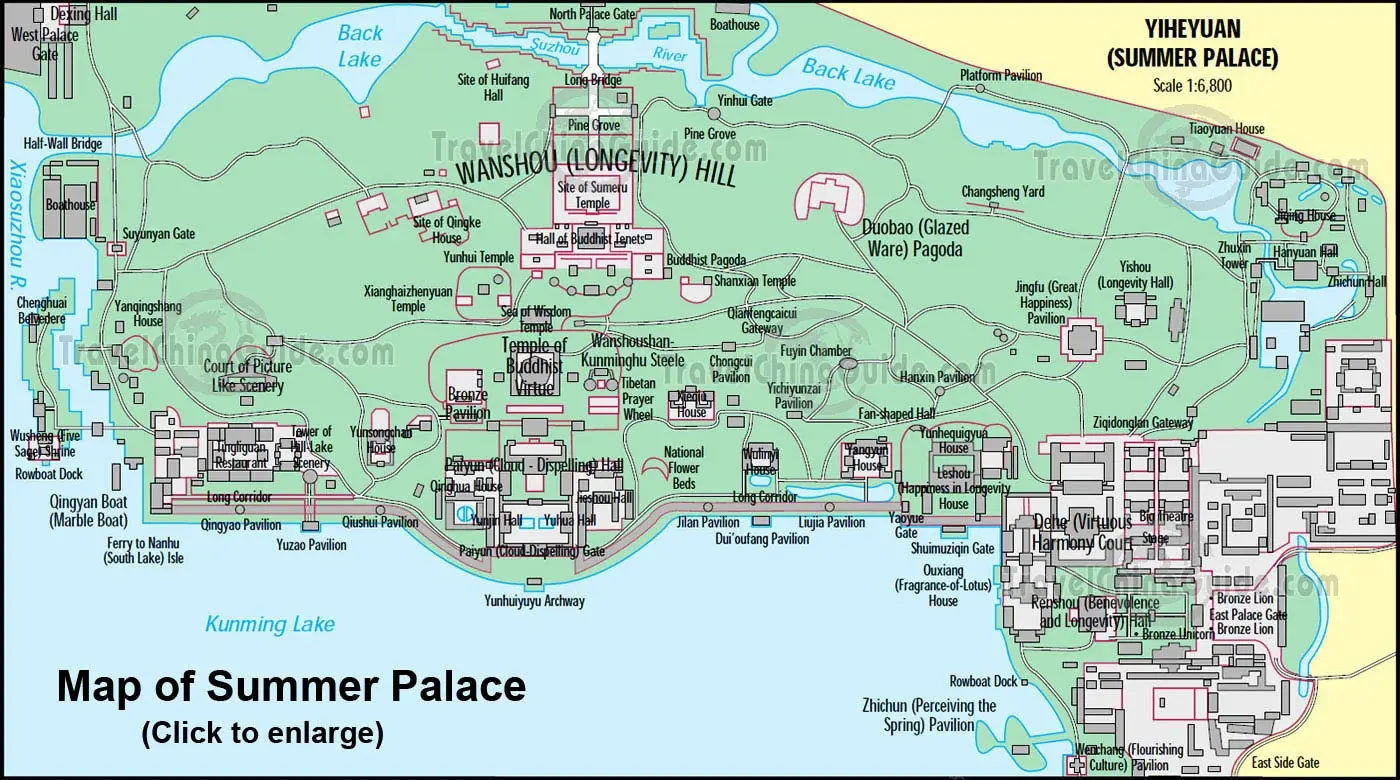
While this map from ChinaHighlights may be more convenient and simple, although doesn’t show everything
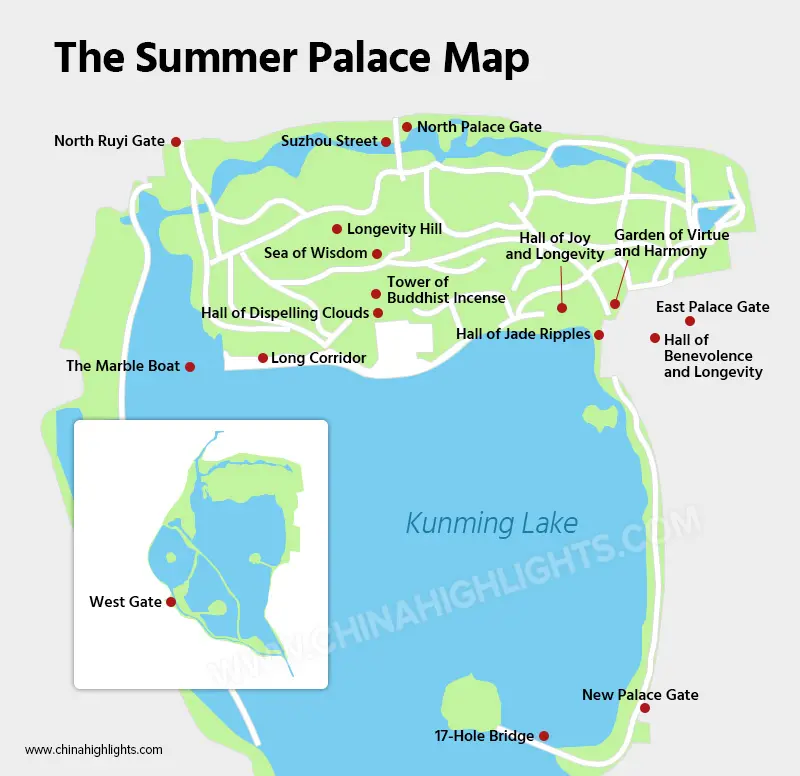
The sightseeing route for the Summer Palace
I will give you the information from North gate to the East, but you can follow the route in the reverse order.
When you are coming from the North gate, the first thing you will see upon entering is the so-called Suzhou street. This market area is located on both sides of the canals. You can marvel at the place from the bridge or go down and walk around seeing the shops.
Longevity Hill
Crossing the bridge, you will end up at the foot of the hill. The Longevity hill lying in front of you is no easy climb, but it’s worth the effort. My mom made it and was very happy that she did.
First, you will see the Four Great regions, which houses 3 statues. It has quite high steps to climb. After you make it, the way towards the Sea of Wisdom Temple is the most complicated, with uneven and steep stone steps, but there are a couple of easier ways, from where even elderly people manage to climb. We looked around a bit and found those steps for mom to be able to climb. I guess best option is to follow the locals, when you see them 🙂
The Sea of Wisdom temple located on top of the hill houses a buddha statue. It’s an architectural marvel with beautiful carvings and colors. It has 1000 Buddhas on its walls, which is a lovely sight.
The temple doesn’t have views, however, you walk a bit more and closeby, you will find the Tower of Buddhist Incense (or fragrance, however you prefer to translate it). Here, you will not only find a beautiful 8-storey pagoda, but also amazing views towards the lake and over the Hall of Clouds.
To go down, I suggest to take stairs, which are located in front of the tower towards the lakeside, as you will have great views, while walking. Alternatively, you can go back to the entrance of the pagoda and take easier stairs down, however, with less marvelous views.
Downstairs, you will end up at the Hall of Dispelling Clouds. This was being renovated at the time we were there. It is another beautiful place. What I like the most were its corridors, particularly, the staircase corridors, which were, unfortunately, closed for visitors. This Hall was used by Empress Dowager Cixi to receive guests and hold various ceremonies.
Kunming Lakeside
Finally, you are at the lakeside. This is where we encountered swamps of people. Up on the Longevity hill, the number of people were far less and it was more quiet and nice. But here, you won’t manage to find a peaceful spot.
From here you have two options – to go along the Long Corridor to your left, which will lead you to the Main court area or to your right to the Marble Boat. From there the boats can bring you to the 17-arch bridge and the island and then you can get off at the east side or go to Suzhou street. If you have enough time, I suggest to do this boat ride.
The Long corridor itself is considered a marvel. It is certainly beautiful, but similarly are all the other corridors we saw all around the summer palace. So instead of trying to get nice picture here, which you won’t manage among the hordes of people, find other beautiful pavilions. They are in so many places, just wonder a bit away from the main tourist groups.
The Court Area
The main court area located closer to the East gate consists of several halls and gardens. Here, the most beautiful was the Dehe garden (of virtue and harmony), where you will find the largest (three-story) concert stage in old China. This part was apparently built by the end of the 19th century, when the Summer palace was rebuilt by Empress Cixi. This stage has highly contributed to the development of theatre and opera.
Don’t miss the Hall of Joyful Longevity nearby, where you will find the huge stone, which is associated with bad luck by many, as its original owner came to financial ruin. This Hall was the living quarters of Empress Cixi.
The Hall of Benevolence and Longevity was the place, where the official business was conducted by the dowager empress Cixi. You will find interesting ornaments and statues here.
Hall of Jade Ripples was used, as living quarters of Emperors. During the time Cixi lived here, she even confined an Emperor Guanxu here for years.
The Heralding spring pavilion has beautiful views over the Tower of Buddhist incense and the lake, so don’t miss a chance to walk around it.
The Wenchang gallery located near the East gate is not as interesting, as we expected, but it was very nice and peaceful in the evening hours. The gallery houses some cultural artifacts.
Finally, you will get to Eastern Gate, which is actually the main entrance to the palace.
Of course, these are not the only things you will be seeing, there are numerous gorgeous pavilions, corridors, small halls and other beautiful sites to admire. But this list will help you not miss the major sites on your way.
Overall, this is an extremely beautiful place and if you have time, I do recommend to spend the whole day here. With more time, you will be able to wonder to the less crowded places, do the boat tour and enjoy your time.
What to Do Next Near the Summer Palace
If you end your visit at the East Gate, as we did, it is about 10-minute walk to the Xiyuan metro station. Nearby the station you will find the so called starry street shopping area with a number of cafes and restaurants.
I do recommend the Green Tea restaurant. This is a popular restaurant chain with dishes from Hangzhou. It has beautiful atmosphere and good food and isn’t too expensive. We came here in the evening at about 7pm and had to wait for our table for about half an hour, but we were used to this in Beijing and it was worth the wait. You will also get a menu meanwhile, so that when you get inside, you already know what to order.
See also:
Step-by-step itinerary for a 4-day trip to Beijing.
Tips and itineraries for visiting China.
Detailed information about the public transportation in China.

Hello I am Ket,
A traveler, planner, and sweet tooth behind Hit the Road Ket.
Travel isn’t just my passion – it’s a lifeline for my mental health. Having lived in three cities and explored 60 countries (and counting!), I created this blog to share my experiences, smart tips, and itinerary advice with fellow travel lovers. I’m all about making the most of limited time, finding scenic routes, and turning every trip into something memorable – coffee in hand, of course.




